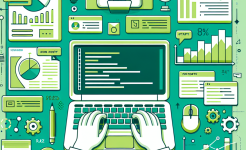Concept Generation
Concept generation is the initial and creative phase of the IPD process. It involves identifying market opportunities, understanding customer needs, and brainstorming ideas for new products or improvements to existing ones. This step sets the foundation for the entire product development cycle.
During concept generation, cross-functional teams come together to gather insights from various sources. Market research plays a vital role in uncovering trends, customer pain points, and competitive landscapes. By analyzing market data, companies can identify gaps that their products can fill. Additionally, engaging with customers directly through surveys, interviews, or focus groups provides valuable feedback on what features and benefits they desire.
Brainstorming sessions within the team encourage the free flow of ideas. Different perspectives from marketing, engineering, design, and other departments are brought to the table. This diversity of thought often leads to innovative concepts that might not have been considered otherwise. The goal is to generate a wide range of ideas, no matter how unconventional they may seem at first. These concepts are then evaluated based on feasibility, market potential, and alignment with the company's strategic goals.
Planning
Once a promising concept is selected, the planning phase kicks in. This step is about creating a detailed roadmap for the product development process. It involves setting clear goals, defining project scope, and allocating resources.
A well-defined project plan includes specific milestones and deadlines. These milestones act as checkpoints throughout the development process, allowing the team to monitor progress and make adjustments if necessary. The scope of the project is carefully outlined, determining what features and functions the product will include and what will be excluded. This helps in managing expectations and ensuring that the project stays focused.
Resource allocation is a critical aspect of planning. It involves determining the human resources, budget, and time required for each stage of the development. Different team members with their respective skills and expertise are assigned to specific tasks. Adequate funding is allocated to cover costs such as research, development, prototyping, and testing. By having a comprehensive plan in place, the team can work towards a common goal in an organized and efficient manner.
Design and Development
The design and development stage is where the product concept starts to take shape. It involves translating the requirements and specifications into a physical or digital product design. This step requires close collaboration between different disciplines.

Engineering teams focus on the technical aspects of the design, ensuring that the product meets performance, reliability, and safety standards. They select the appropriate materials, components, and manufacturing processes. Designers, on the other hand, are concerned with the user experience and aesthetics. They create intuitive interfaces, attractive packaging, and ergonomic designs that enhance the product's appeal.
Prototyping is an important part of this stage. It allows the team to build a working model of the product to test its functionality and usability. By creating prototypes, potential issues can be identified and resolved early in the process, saving time and resources. Multiple iterations of the design may be required based on the feedback received from testing the prototypes. This iterative approach ensures that the final product is of high quality and meets the customer's expectations.
Testing and Validation
Testing and validation are crucial steps to ensure that the product meets the defined requirements and performs as expected in real-world scenarios. This stage involves a series of tests to evaluate different aspects of the product.
Functional testing verifies that the product's features and functions work as intended. It checks for any bugs, glitches, or errors in the product's operation. Performance testing assesses the product's speed, reliability, and scalability under different conditions. This helps in identifying any bottlenecks or performance issues that need to be addressed.
Usability testing focuses on the user experience. It involves observing how real users interact with the product and gathering feedback on its ease of use, intuitiveness, and overall satisfaction. By conducting usability testing, the team can make improvements to the product's design to enhance the user experience. Additionally, compliance testing ensures that the product meets all relevant industry standards and regulations.
Launch and Commercialization
The final step in the IPD flowchart is the launch and commercialization of the product. This is when the product is introduced to the market and made available to customers. A successful launch requires careful planning and execution.
Marketing and sales strategies are developed to create awareness and generate demand for the product. This includes activities such as advertising, public relations, and social media campaigns. Pricing strategies are also determined to ensure that the product is competitive in the market while still generating a profit for the company.
Distribution channels are established to make the product accessible to customers. This may involve working with retailers, wholesalers, or online platforms. Customer support services are put in place to address any issues or concerns that customers may have after purchasing the product. Post-launch, continuous monitoring and evaluation are carried out to gather feedback from the market and make any necessary improvements or enhancements to the product.
In conclusion, the five key steps in the IPD flowchart - concept generation, planning, design and development, testing and validation, and launch and commercialization - are all integral to a successful product development process. Each step builds on the previous one, and a smooth transition between them is essential. Concept generation provides the creative spark, while planning sets the direction and framework. Design and development bring the product to life, testing and validation ensure its quality, and launch and commercialization make it available to the market. By following these steps in a systematic and collaborative manner, companies can increase their chances of developing products that meet customer needs, are competitive in the market, and drive business growth. Moreover, continuous improvement and learning from each product development cycle can further enhance the effectiveness of the IPD process, enabling companies to stay ahead in an ever-evolving business landscape. This structured approach not only streamlines the product development process but also helps in optimizing resources, reducing risks, and ultimately delivering products that create value for both the company and its customers.
ARTICLE TITLE :Analysis of 5 key steps in the IPD flowchart ,AUTHOR :ITpmlib

















